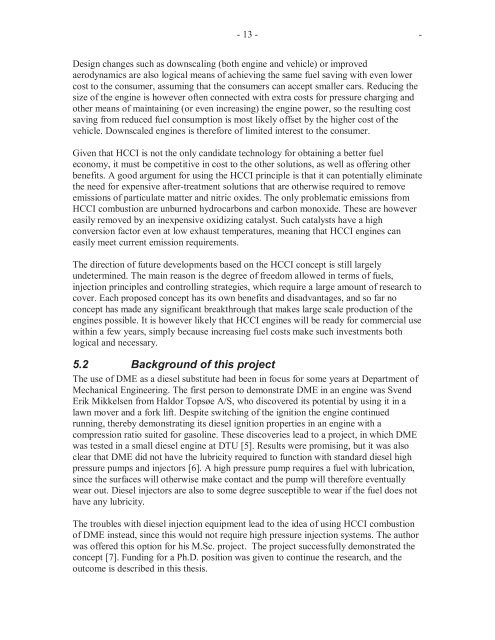Troels Dyhr Pedersen.indd - Solid Mechanics
Troels Dyhr Pedersen.indd - Solid Mechanics
Troels Dyhr Pedersen.indd - Solid Mechanics
You also want an ePaper? Increase the reach of your titles
YUMPU automatically turns print PDFs into web optimized ePapers that Google loves.
- 13 - -<br />
Design changes such as downscaling (both engine and vehicle) or improved<br />
aerodynamics are also logical means of achieving the same fuel saving with even lower<br />
cost to the consumer, assuming that the consumers can accept smaller cars. Reducing the<br />
size of the engine is however often connected with extra costs for pressure charging and<br />
other means of maintaining (or even increasing) the engine power, so the resulting cost<br />
saving from reduced fuel consumption is most likely offset by the higher cost of the<br />
vehicle. Downscaled engines is therefore of limited interest to the consumer.<br />
Given that HCCI is not the only candidate technology for obtaining a better fuel<br />
economy, it must be competitive in cost to the other solutions, as well as offering other<br />
benefits. A good argument for using the HCCI principle is that it can potentially eliminate<br />
the need for expensive after-treatment solutions that are otherwise required to remove<br />
emissions of particulate matter and nitric oxides. The only problematic emissions from<br />
HCCI combustion are unburned hydrocarbons and carbon monoxide. These are however<br />
easily removed by an inexpensive oxidizing catalyst. Such catalysts have a high<br />
conversion factor even at low exhaust temperatures, meaning that HCCI engines can<br />
easily meet current emission requirements.<br />
The direction of future developments based on the HCCI concept is still largely<br />
undetermined. The main reason is the degree of freedom allowed in terms of fuels,<br />
injection principles and controlling strategies, which require a large amount of research to<br />
cover. Each proposed concept has its own benefits and disadvantages, and so far no<br />
concept has made any significant breakthrough that makes large scale production of the<br />
engines possible. It is however likely that HCCI engines will be ready for commercial use<br />
within a few years, simply because increasing fuel costs make such investments both<br />
logical and necessary.<br />
5.2 Background of this project<br />
The use of DME as a diesel substitute had been in focus for some years at Department of<br />
Mechanical Engineering. The first person to demonstrate DME in an engine was Svend<br />
Erik Mikkelsen from Haldor Topsøe A/S, who discovered its potential by using it in a<br />
lawn mover and a fork lift. Despite switching of the ignition the engine continued<br />
running, thereby demonstrating its diesel ignition properties in an engine with a<br />
compression ratio suited for gasoline. These discoveries lead to a project, in which DME<br />
was tested in a small diesel engine at DTU [5]. Results were promising, but it was also<br />
clear that DME did not have the lubricity required to function with standard diesel high<br />
pressure pumps and injectors [6]. A high pressure pump requires a fuel with lubrication,<br />
since the surfaces will otherwise make contact and the pump will therefore eventually<br />
wear out. Diesel injectors are also to some degree susceptible to wear if the fuel does not<br />
have any lubricity.<br />
The troubles with diesel injection equipment lead to the idea of using HCCI combustion<br />
of DME instead, since this would not require high pressure injection systems. The author<br />
was offered this option for his M.Sc. project. The project successfully demonstrated the<br />
concept [7]. Funding for a Ph.D. position was given to continue the research, and the<br />
outcome is described in this thesis.

















